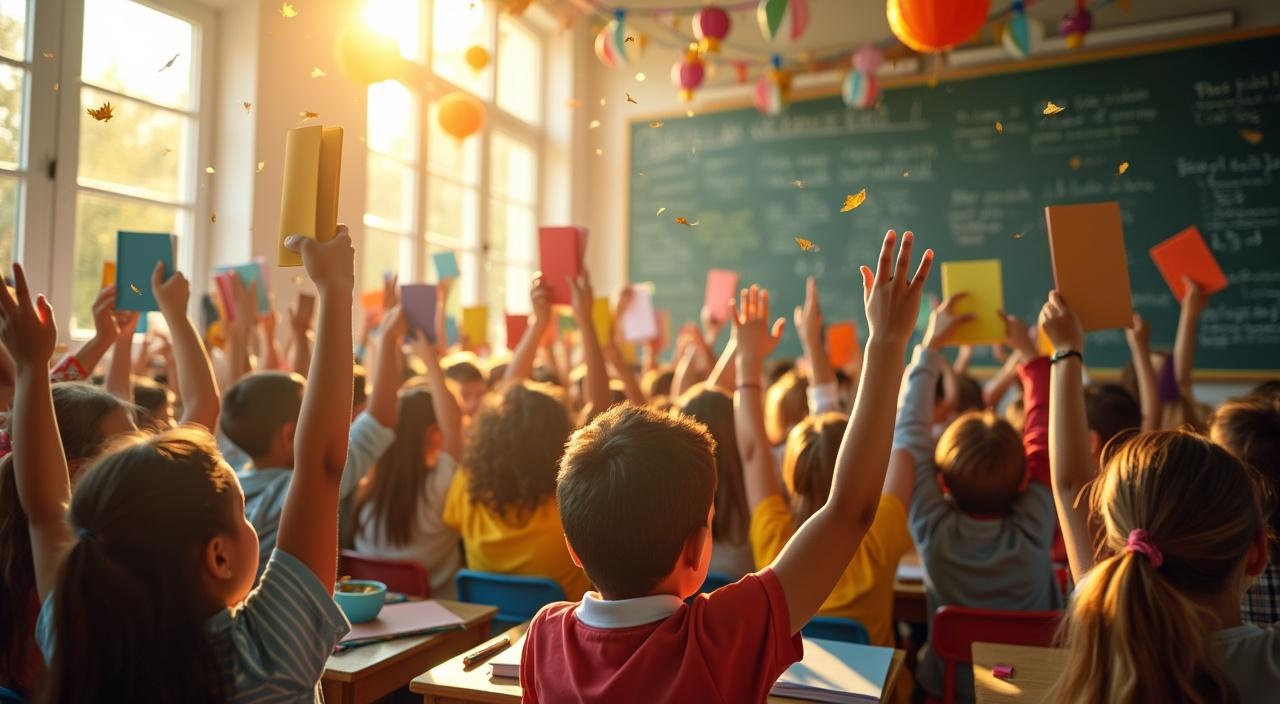Back-to-school isn’t just about shopping lists and new notebooks—it’s a transformative journey of curiosity and growth. Smart families are reimagining education as an adventure of discovery, turning traditional learning approaches upside down by focusing on wonder, hands-on experiences, and strategic preparation.
Key Takeaways:
- Early preparation is crucial, with 67% of families starting back-to-school shopping by early July
- Shift from grade-focused to curiosity-driven learning dramatically improves student engagement
- Hands-on activities and practical challenges make learning more meaningful and memorable
- Strategic transition strategies help reduce student anxiety and build confidence
- Creating supportive home learning environments involves consistent routines and open communication
I remember the stress of back-to-school season when my kids were younger—endless supply lists, last-minute shopping, and that familiar knot of anxiety as summer freedom gave way to structured days. Like you, I’ve experienced both the excitement and the challenges this season brings.
The data shows we’re not alone. According to recent research, 67% of families start their back-to-school shopping by early July, understanding that early preparation reduces stress and allows for more thoughtful choices.
The Curiosity Revolution
Have you noticed how our education system often prioritizes grades over actual learning? This backward approach has bothered me throughout my career working with businesses and families alike.
The most successful students I’ve encountered share one common trait: genuine curiosity. When children learn because they’re interested rather than just for a grade, their engagement skyrockets. This isn’t just my observation—it’s backed by cognitive science.
Here’s what I mean: When a child is curious about a topic, their brain releases dopamine, making the learning experience rewarding and creating stronger neural connections. This natural chemistry makes information stick better than any forced memorization ever could.
Let that sink in.
Hands-On Learning Creates Lasting Knowledge
The best education happens through experience. I’ve seen this firsthand in my own learning journey across three countries and languages.
Picture this: A student reading about physics principles versus actually building a simple machine that demonstrates those principles. Which lesson do you think will stay with them longer?
Strange but true: Studies show that information learned through practical application has a retention rate up to 75% higher than information acquired through passive reading or listening.
This insight applies beautifully to how we prepare children for school. Instead of focusing solely on textbooks, smart parents are creating learning environments that encourage experimentation and practical application. This approach builds both knowledge and problem-solving skills that serve children throughout their lives.
Strategic Transitions Reduce Anxiety
The good news? You can significantly reduce back-to-school anxiety with strategic planning.
School transitions create legitimate stress for children of all ages. Their concerns about new teachers, changing friendships, and increased academic demands are valid. As parents and mentors, acknowledging these feelings is our first responsibility.
But wait – there’s a catch: Simply recognizing anxiety isn’t enough. We need practical strategies to help children build confidence.
I recommend gradually adjusting sleep schedules 2-3 weeks before school starts. This simple step helps prevent the physical and emotional stress of sudden schedule changes. Additionally, visiting the school and meeting teachers before classes begin can transform the unknown into the familiar.
Creating Supportive Home Learning Environments
The physical space where learning happens matters tremendously. Research indicates that organized, comfortable learning environments improve focus and reduce distraction.
This doesn’t require expensive redesigns. Simple changes make profound differences:
- Designate a specific area for homework and study
- Eliminate visual clutter from work spaces
- Ensure proper lighting to reduce eye strain
- Create systems for organizing school materials
- Establish consistent routines for homework time
These practical adjustments signal to your child’s brain that it’s time to focus, making the transition between play and study clearer and less stressful.
The Technology Balance
Finding the right balance with technology represents one of our greatest parenting challenges. Digital tools can either enhance or hinder learning, depending on how we integrate them.
I’ve found that the most effective approach treats technology as a tool rather than entertainment. Set clear boundaries around screen time, emphasizing educational applications that encourage active thinking rather than passive consumption.
Here’s the twist: The latest AI-driven educational resources can actually personalize learning in ways traditional education can’t. These tools adapt to your child’s specific needs, providing targeted practice in areas where they need more support.
The Shifting Educational Landscape
Public education is changing rapidly. Recent data shows significant enrollment shifts away from traditional public schools, with families exploring alternative options including charter schools, private education, and homeschooling.
This trend reflects growing parental desire for more personalized, effective educational approaches. Many families are supplementing traditional education with customized learning experiences that address their children’s specific needs and interests.
Financial Planning for Educational Success
Back-to-school shopping creates significant financial pressure. The average family spends over $500 per child on school supplies, clothing, and technology each year.
I recommend creating a detailed budget before shopping begins. This simple step prevents impulse purchases and ensures your resources go toward items that truly support learning.
Smart shopping strategies include:
- Taking inventory of supplies you already have
- Looking for tax-free shopping days in your state
- Buying quality items for frequently used supplies
- Shopping gradually to spread out expenses
- Teaching children budgeting skills by involving them in the process
Embracing the Learning Journey
Education works best when we view it as a continuing adventure rather than a series of required tasks. The most valuable skills children can develop aren’t tied to specific subjects but to their approach to learning itself.
Critical thinking, creative problem-solving, and the ability to adapt to new situations will serve children far better than memorized facts. These skills prepare them not just for tests but for life’s unpredictable challenges.
I encourage you to share your own learning experiences with your children. When they see your curiosity and willingness to tackle new subjects, they develop a healthier relationship with education.
The back-to-school season offers more than a return to classrooms—it provides an opportunity to reshape how your family approaches learning altogether. By focusing on curiosity, practical application, and supportive environments, you can transform education from a requirement into an adventure that serves your children throughout their lives.
The Back-to-School Landscape: A Statistical Snapshot
The numbers tell a compelling story about how families approach back-to-school preparation. Sixty-seven percent of back-to-school shoppers began purchasing by early July 2025. This early bird approach isn’t just about organization—it’s about economics.
Average family spending reaches $858.07 for K-12 students and $1,325.85 for college students. College families face nearly double the financial burden, making smart planning even more crucial.
Here’s what drives this early shopping behavior: 51% of shoppers start early due to tariff and inflation concerns. Families aren’t just preparing for school—they’re protecting their budgets against rising costs.
These patterns reflect a shift in consumer behavior. Parents now view back-to-school shopping as a strategic financial decision rather than a last-minute scramble.

Reframing Learning: From Pressure to Curiosity
I’ve watched too many students burn out before they even hit middle school. The relentless focus on grades and test scores crushes the natural curiosity that makes learning magical.
Here’s what changed everything for me: switching from “What grade did you get?” to “What surprised you today?” This simple shift transforms anxiety into excitement. When my daughter started asking her own questions about photosynthesis instead of memorizing definitions, her science grades actually improved—but more importantly, she started loving discovery.
High schoolers aren’t misusing AI—they’re showing us how curiosity-driven learning works. They explore, experiment, and create because they want answers, not because they fear punishment.
Early planning makes this possible. Set up learning spaces that invite questions. Replace “study harder” with “wonder more.” The pressure melts away when kids become their own learning detectives.
https://music.youtube.com/playlist?list=PL2nQmAErrUBG43ggYD41wUs8EeCUOURyR
Hands-On Learning: Curiosity in Action
Learning comes alive when children touch, build, and experiment. I’ve watched countless kids transform from passive observers into active discoverers through simple hands-on activities.
STEM Adventures That Stick
The paper bridge design challenge never fails to amaze me. Kids use just newspaper and tape to build bridges that hold surprising weight. They learn engineering principles without realizing it. Seed germination tracking turns any windowsill into a laboratory where children document growth patterns daily.
Here’s the twist: ‘Budget the Backpack‘ makes math real. Students calculate costs, compare prices, and work within spending limits using actual school supply catalogs.
Beyond Science and Math
Literacy comes alive through detective work. Students investigate local history, interview community members, and create their own neighborhood stories. Social studies transforms when children map their daily routes and discover the geography hiding in plain sight.
These activities don’t require expensive equipment or fancy labs. A curious mind and everyday materials create the most powerful learning experiences.

Transition Strategies: Preparing Mind and Body
Smart parents know the secret: successful school transitions start weeks before the first bell rings. I’ve watched countless families struggle with abrupt schedule changes, and there’s a better way.
Building Your Back-to-School Foundation
Start adjusting bedtimes 15 minutes earlier each night, beginning two weeks before school starts. This gradual approach prevents the shock of suddenly demanding your child sleep at 8 PM when they’ve been staying up until 10 PM all summer. School-age children need 9-12 hours of sleep, but cramming this change into one night creates unnecessary battles.
Physical preparation goes beyond buying new shoes. Here’s what actually works for busy families:
- Practice the morning routine with timed dress rehearsals
- Reintroduce structured meal times that mirror school schedules
- Build in short bursts of focused activity to strengthen attention spans
- Create quiet reading periods that simulate classroom concentration
Mental preparation matters just as much. Children often carry unspoken worries about new teachers, making friends, or academic challenges. I address this head-on by creating space for honest conversations about their concerns.
Anxiety management doesn’t require expensive therapy sessions. Simple breathing exercises work wonders. Teach your child to count to four while inhaling, hold for four, then exhale for four counts. Practice this together during calm moments so they can access it when stress hits.
The magic happens when you combine these elements consistently. Your child’s body clock adjusts naturally, their confidence builds through practice, and anxiety shrinks when they feel prepared. The investment in systematic preparation pays dividends in smoother mornings and happier children throughout the school year.
Building a Supportive Learning Environment
Creating the right learning space isn’t rocket science, but it makes all the difference. I’ve seen families transform kitchen tables into productivity powerhouses with simple changes.
Start with dedicated study zones at home. Clear boundaries matter more than fancy furniture. Your child’s brain craves consistency, so the same spot signals “time to focus.” Remove distractions but keep supplies within arm’s reach.
Support Systems That Actually Work
Build bridges between home and classroom through these proven strategies:
- Schedule weekly check-ins with teachers before problems arise
- Create visual schedules using colors or icons your child understands
- Establish consistent homework routines that mirror classroom expectations
- Share what works at home with teachers, and vice versa
Parent-teacher collaboration isn’t just nice-to-have anymore. Recent enrollment shifts show parents are more involved than ever in educational decisions.
The magic happens when home and school speak the same language about expectations, rewards, and consequences.
https://www.youtube.com/post/UgkxNdlQcAn1ppbXY_AjgqoEhMGIMRk2ir5b
Celebrating the Learning Journey
I’ve watched my own children transform when we shifted from focusing on grades to celebrating their curiosity. Small wins matter more than you might think.
Picture this: your child solves a tricky math problem after struggling for twenty minutes. That moment deserves recognition just as much as any test score. I started creating what I call “curiosity checkpoints” – moments where we pause to acknowledge effort, not just outcomes.
Building Momentum Through Recognition
Smart parents track engagement differently than schools do. Here’s what actually works in my experience:
-
• Daily “aha moments” – capture one thing that sparked interest
• Weekly curiosity challenges – encourage questions over answers
• Monthly reflection sessions – discuss what made learning fun
The research backs this up too. Kids who receive recognition for their learning process, not just results, show higher engagement rates throughout the academic year.
I remember when my daughter started asking “why” about everything again after we began celebrating her questions. That shift from performance anxiety to genuine wonder? That’s the real victory worth tracking.

Sources:
• National Retail Federation
• CBS News








